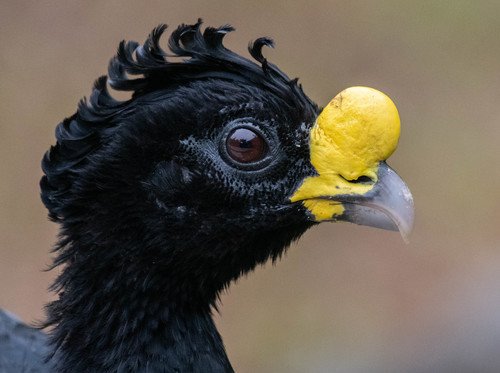
Great Curassow
The Great Curassow (*Crax rubra*) is a large, pheasant-like bird found in the rainforests of Central and South America. It is notable for its distinctive curled crest of feathers and its significant role in seed dispersal within its ecosystem. Males are primarily black, while females exhibit a range of color morphs. The species faces increasing pressure from habitat loss and hunting, leading to its classification as Vulnerable. In some indigenous cultures, the Great Curassow is a symbol of the rainforest and features in local folklore.
78-92 cm
Length
Not Evaluated cm
Wingspan
Vulnerable
Conservation Status
Distribution
From eastern Mexico through Central America to western Colombia and northwestern Ecuador in South America. They typically inhabit lowland rainforests, but their altitudinal range can extend up to 1,900 meters (6,200 feet).
Lifespan
Up to 24 years in captivity; wild lifespan is less well-documented but likely shorter.
Great Curassow's Habitat
Habitat Types
Humid lowland forests, Tropical rainforests, Mature secondary forests, Occasionally in drier forest areas
Climate Zones
Tropical
Adaptations
Their strong legs and large feet are adapted for foraging on the forest floor. The relatively large body size helps with navigating dense undergrowth.
Variations
Two subspecies are generally recognized: *Crax rubra rubra* and *Crax rubra griscomi*. *C. r. griscomi* is found only on Cozumel Island and is smaller and displays slight plumage differences compared to the mainland subspecies.
Appearance
Breeding Plumage
No significant seasonal variation in plumage is observed.
Seasonal Feather Changes
None
Sex Based Plumage Differences
Males are mostly black with a white belly and undertail coverts. Females exhibit polymorphism, occurring in three main color morphs: barred, rufous, and dark. These morphs differ in the barring and coloration of their upperparts, wings, and tail.
Notable Features
Prominent curled crest of feathers on the head., Yellow knob on the bill (more prominent in males)., White undertail coverts., Strong, robust legs.
Diet and Feeding
Primary Foods
Fruits, Seeds, Insects, Small invertebrates, Occasionally small vertebrates
Foraging Behavior
Primarily forages on the ground, scratching and pecking at leaf litter to find food. They also occasionally climb into trees to feed on fruits.
Specializations
Their strong bill is adapted for cracking open hard seeds and nuts.
Seasonal Diet Variations
Diet may shift depending on fruit availability, with a greater reliance on insects and invertebrates when fruits are scarce.
Behavior
Social Structure
Usually found solitary, in pairs, or in small family groups.
Communication
Low-frequency booming calls (primarily by males)., Wing-drumming during courtship., Alarm calls when threatened.
Migration
Non-migratory; they are resident within their range.
Territorial or Group Behaviors
Males are territorial, especially during the breeding season, defending their area against rivals.
Conservation
Threats
Habitat loss due to deforestation (agriculture, logging)., Hunting for food and sport., Fragmentation of habitat, isolating populations.
Protection Programs
Protected areas within their range (e.g., national parks, reserves)., CITES Appendix III listing (regulates international trade)., Some community-based conservation initiatives.
Local National Laws
Protected under national wildlife laws in several countries within its range, but enforcement can be challenging.
Population Trend
Decreasing
Population Estimates
The global population is estimated to be between 20,000 and 49,999 individuals.
Interesting Facts
They are one of the largest bird species in the Neotropical rainforests.
This makes them an important component of the ecosystem, especially for seed dispersal.
The female's plumage polymorphism is relatively unusual among birds.
The different color morphs may offer some adaptive advantage, but the exact reasons are not fully understood.
The booming calls of the males can be heard over considerable distances.
These calls are used to attract mates and defend territories.
Faqs about Great Curassow
What is the biggest threat to Great Curassows?
Habitat loss due to deforestation and hunting are the primary threats.
Are Great Curassows endangered?
They are classified as Vulnerable by the IUCN, meaning they face a high risk of extinction in the wild.
What do Great Curassows eat?
They primarily eat fruits, seeds, insects, and small invertebrates found on the forest floor.
How many eggs Great Curassows lay?
They typically lay 2 eggs.
Copyright @ Nature Style Limited. All Rights Reserved.
 English
English